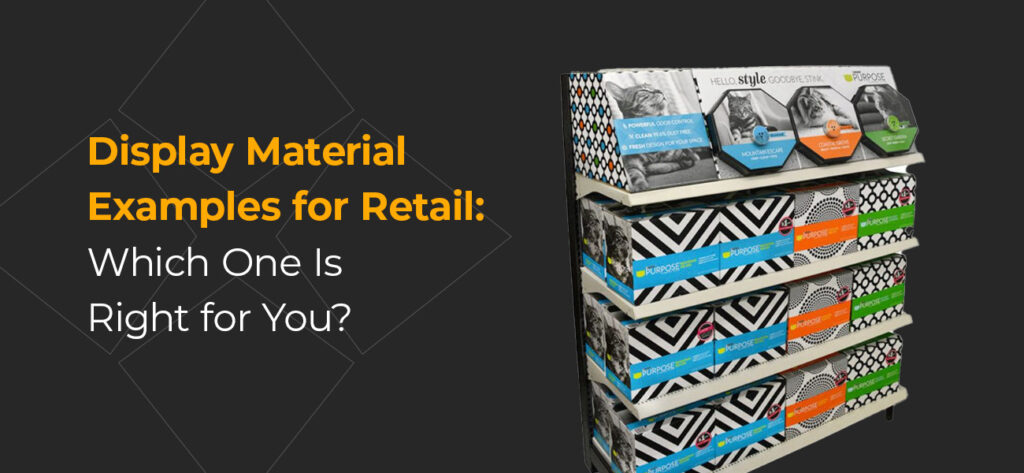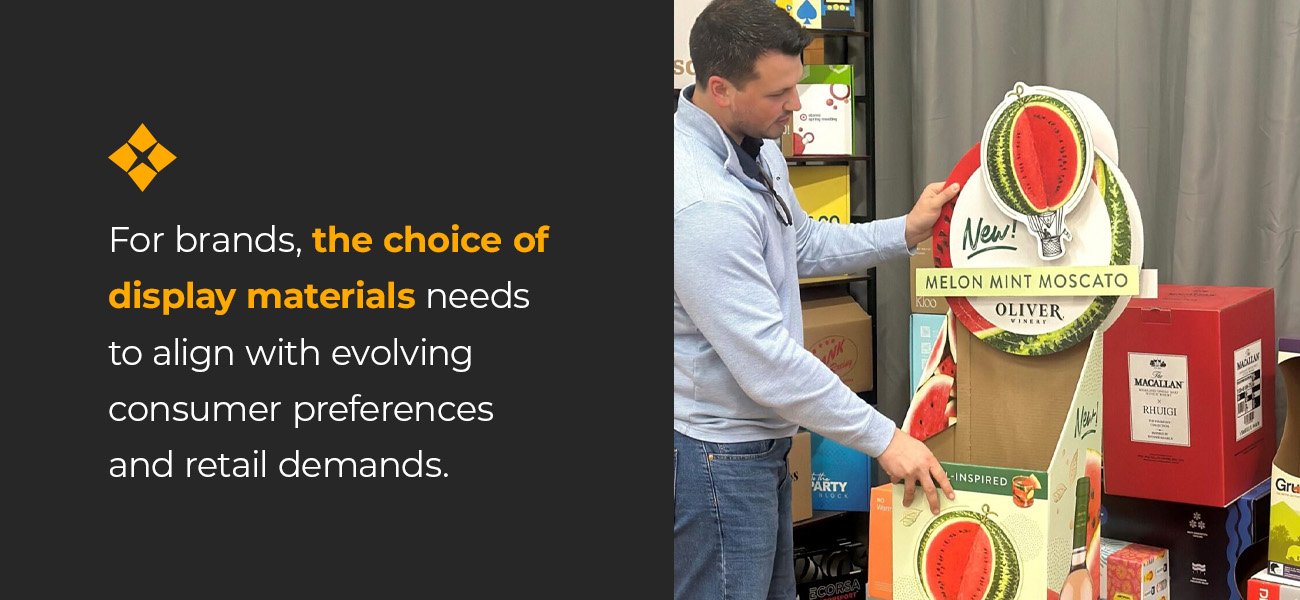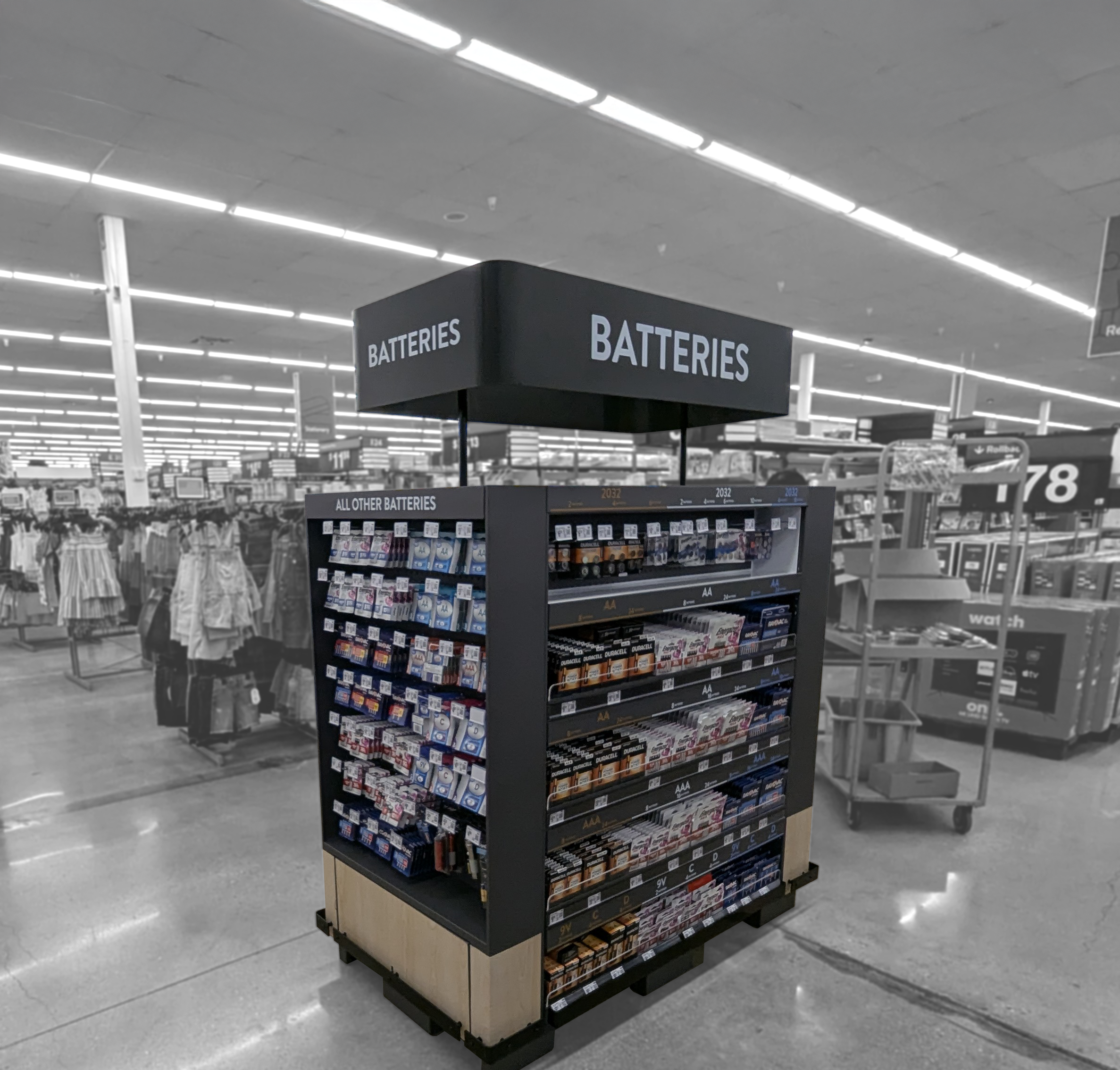
Point of purchase (POP) displays are an excellent way to help brands encourage impulse buys, introduce new products and increase sales. Designing an effective display involves many decisions. One of the critical initial choices is choosing which materials you will use. A suitable material can be the difference between a successful campaign and one that misses the mark. After all, each option contributes to branding and the impressions consumers have toward your products. The construction can also determine how long your display will last in stores.
So, which POP display material is right for your Merchandising campaign? This guide discusses display material examples and their strengths to help you make the right decision.
Here is a list of materials used for retail displays:
Corrugated Cardboard
The popularity of cardboard displays as a short-term promotional solution makes them ideal in many situations. Cardboard has many impressive properties that make it a reliable option. It is strong, flexible, lightweight, environmentally friendly and readily available, which makes it cost-effective.
Benefits and Applications
The flexibility of corrugated cardboard makes it possible to use it in a diverse array of design options and configurations. It is the material of choice for POP displays, such as end cap trays, stand-alone floorstands, temporary side caps and pallet displays, which are designed to attract attention. Some of the benefits of corrugated include:
- Extreme flexibility during production and assembly
- Design versatility
- Easy to transport
- Sustainable and recyclable
- More affordable than other display materials
- Lightweight and easy to handle
Acrylic
Acrylic is a popular plastic material with excellent capabilities in retail displays. The plastic is known for its durability, longevity and lightweight characteristics, making it a perfect option for permanent and semi-permanent displays. Because of its appearance, it is also used for high-end products.
Benefits and Applications
Due to its strength and lightweight features, acrylic is a common material for retail aisle shelves, gondolas and other stand-alone racks. Some of the benefits of acrylic include:
- Multiple color options
- High strength and durability
- Diverse style and size options
- Attractive and high-quality appearance
- Easy to transport and handle
Wood
Wood is a unique material that creates a rustic, industrial or homey aesthetic when used in retail displays. These traditional displays are often in demand for their natural appearance, which favors promotional items and other special products. Wooden POP displays are strong and durable.
Benefits and Applications
Wood is an ideal material for warm and natural displays. It makes eye-catching POP displays, such as display racks, cantilevered shelves and bulk bins. Some of the benefits of wooden retail displays include:
- Strong and longlasting
- Natural and legacy aesthetics
- Impact resistant
- Environmental friendly
- Diverse finish options
Metal
Metal is a strong and versatile material suitable for many retail display applications. Due to its exceptional durability, retail metal displays are usually a permanent solution and can be molded into various shapes to match your style preferences.
Benefits and Applications
Metal displays have diverse applications in retail stores. Due to their strength and stability, metal is the material of choice for the main gondolas and certain island displays. Here are some of the benefits of metal:
- Strong and longlasting
- Reliable for heavy items
- Diverse shelving configurations
- Easy to assemble
- Lightweight options available
Factors to Consider When Selecting Display Materials
Choosing the right material for your display is critical. Here are a few factors to consider in your selection.
1. Cost
When choosing retail display materials, one of your top concerns is the upfront costs. Each material can affect the overall engineering and manufacturing costs in different ways. In general, corrugated cardboard is the most cost-effective. Since cardboard displays are lightweight, they are more affordable to package, store and ship. Cardboard is also made from recycled materials, making it a sustainable choice.
Acrylic is also an affordable choice that provides durability while being lightweight. It can also be clear, a unique quality that allows your product to stand out.
Wire racks are another cost-effective option for companies who want to use metal. More complex metal designs may cost more. Steel can be very flexible and can be cut, bent and welded into many unique designs. Powder coating can make the display unique for your brand.
The cost of a wood display will depend on the type of wood and finishes required.
While cost-effectiveness is always important, some product marketers want to invest more in their POP displays. Choosing a more expensive material option will offer higher quality and durability. Shoppers will see the difference when they notice an impactful display in the store. The right display material can communicate the quality or luxuriousness of the products it shows off.
At Great Northern Instore, we know that every brand has different POP budgets. Our designers can value engineer a retail display using any material. We’ll find a unique blend of materials that will look good and increase sales while also meeting your budget and hitting your goals.
2. Durability
For durability, the main question to ask yourself is how long the display needs to last. Is it a temporary display for your latest promotion or a permanent installation? When designed by an expert, a corrugated cardboard display can be sturdy enough to withstand daily retail use for a few months. It is excellent for limited-time promotions. The low-cost and low-durability display material makes it easy to customize your designs with the season or as new sales and promotions roll out.
For a display that will last years, consider plastic, metal or wood. For permanent and semi-permanent displays, each material differs in durability. Plastic offers excellent longevity for semi-permanent displays. This feature makes it the better option for a longer-term setup over cardboard.
After a few years, plastic can show signs of fading and cracking. If the display must last even longer, consider metal or wood. Depending on the thickness, type and finish, wood makes an excellent semi-permanent and permanent display option. Metal displays can last for many years with the proper upkeep.
3. Movement
A display that is easy to move is beneficial for many reasons. There are two types of movement to consider: logistics through the supply chain and the ability to be portable in the retail environment. First, a well-designed display helps make assembly, packing and shipping logistics more manageable. If your designs are easy to load and unload, you will likely save on transportation costs. Once the displays reach the store, a portable design improves flexibility.
The flexibility in moving displays around the store allows for a more attractive placement. Easy-to-move displays can offer simpler logistics and faster assembly. In the store, cardboard and acrylic are easier to move around because they are lightweight. You can also use castors for portability on metal or wood displays.
Cardboard does not need heavy lifting. Throughout the packaging, stocking, shipping and assembly process, it remains easy to transport. The ease of assembly and movement also improves retailer compliance. When store workers can assemble and move your cardboard display without strain or difficulty, they are more likely to set it up how it was intended.
Metal is also easy to assemble. A metal wire display may unfold into its intended structure, making it easy to arrange as needed. Other metal displays can be heavy or light, depending on the material used. Permanent retail display fixtures can also improve movability. Adjustable metal shelves and hooks let retailers and brands customize their long-term displays later on.
While movability is often important, not all cases require it. If you need a long-term retail display fixture, you can choose heavier materials for shelves, stands or racks that bolt into place.
4. Protection
When displaying fragile or expensive items, consider how to protect them. Items in well-designed packaging, such as plastic or cardboard, should not break easily. However, the busy retail environment increases the risk of damage to products. Consumer electronics, glass beverages or cosmetics bottles and jewelry need extra protection.
In this case, metal, plastic or wood will offer better impact resistance. These fixtures absorb the impact of a shopping cart or mop and will stand steady even if a shopper bumps into or rocks them. Bolting permanent shelving and installations into the walls or floors can also add protection.
If your product is a theft risk, you might consider recreating the product in three dimensions using plastic or cardboard. These displays let you advertise your products while the expensive items stay behind a security case.
5. Branding
Each retail display material offers a different look and feel. Many companies want to match their chosen display material to their product branding. As you consider your material options, keep in mind the aesthetic, design flexibility and consumer attitudes associated with each material.
- Cardboard: Corrugated cardboard offers incredible design flexibility. Retail display manufacturers can cut and fold the material into different desired shapes. With large-format printing capabilities, cardboard displays offer various vibrant color options and photo-quality prints. While cardboard is a low-cost option, that doesn’t usually factor into consumer attitudes.
- Acrylic: This plastic material offers a higher-end look over cardboard. Acrylic retail displays look more durable, and the sleek, smooth surface can add to the appeal. Like cardboard, it is easy to mold acrylic into different shapes. One unique advantage of plastic is that transparent acrylic puts your product at the forefront. Minimalist brands often use transparent product holders to highlight their products without any added noise or bulk. Whether colored, printed or translucent, the sleek surface adds a sophisticated look.
- Wood: Wood is a versatile display material and relatively easy to carve and shape. It can be stained to highlight the natural wood grains or to mimic certain wood species. Wood has a distinct look yet can create a rustic, industrial or nature-inspired aesthetic. Our previous work shows you the branding possibilities for wood displays. For example, we used a wooden frame to mimic a chalkboard easel for a Starbucks cold brew launch. The look kept the product’s glass bottles at the forefront while elevating their appearance. Wood is also a natural material that conveys a sustainable message to shoppers.
- Metal: Metal is another retail display material that can fit many brand aesthetics and purposes. In general, it offers a distinguished look. Metal displays can feature vibrant printed colors and matte or glossy finishes. We can also work to create a metal look from plastic or corrugated displays. Like plastic, metal looks higher-end than cardboard. Usually, metal displays feature paper or cardboard-printed graphics to enhance branding. These signs could be designed for easy changes so your messaging stays relevant throughout the year.
6. Environmental Impact and Upkeep
With the world moving toward sustainability, more consumers are prioritizing eco-friendly products. For brands, the choice of display materials needs to align with evolving consumer preferences and retail demands. Here is how different display materials impact the environment:
- Cardboard: At the end of a retail display’s life, cardboard is easy to break down and recycle. Plus, at Great Northern Instore, our cardboard displays contain 60%-95% recycled content. They are also 100% recyclable. With cardboard, you can rest assured your POP displays will have minimal environmental impacts.
- Metal: The advantage of permanent displays like metals is that they last longer and generate less waste. Most are also easy to recycle. We use steel, one of the most recycled materials in the U.S.
- Wood: Wood is not easy to recycle, but it can often be reused. For instance, wood pallets have nearly infinite uses for retailers and many other industries. We can work with you to create metal or other long-term retail merchandise display fixtures that will be recyclable at the end of their service life.
Tips for Matching Your Display Material to Your Product
One of the biggest considerations for material selection is how your displays will complement the product. Display materials that match the product are attractive enough to draw in your target customers.
Next, consider how the color and finish look in reference to your products. A glossy finish could clash with a product that has a matte finish and vice versa. You also want the material to match the overall feel of your product. An industrial-looking wire rack will not match the aesthetics of delicate jewelry or cashmere sweaters. For these luxury items, a better choice might be a natural wood or clear acrylic shelf.
Here are some of the products each display material pairs well with:
- Cardboard: Cardboard displays are widely applicable and can be customized to fit consumer packaged goods across all industries. Because cardboard can feature vibrant colors and various finishes, it can complement practically any product. Consumer electronics, food and beverages, beauty items and toys are a few products that can stand out in a temporary corrugated display.
- Acrylic: Acrylic offers a sleek, glossy or matte surface. This feature makes it ideal for displaying clothing. The smooth surface allows clothes to easily glide in and out of the display as store employees restock and shoppers look for their sizes. Plastic is colorful and customizable, which makes it a versatile material rivaling cardboard. Sporting goods, home improvement tools and health and beauty items can all fit right at home on a plastic display.
- Wood: Wood can look rustic, natural and high-end, highlighting certain products well. Food, wine and whiskey can all play on the rustic, old-world look. Collectors’ editions of toys and games use higher-end materials like wood to portray the added value. Wood is also commonly used for bookcases and other home furnishings, so housewares and books both stand out on wood retail display shelves. Unfinished or finished wood can also complement home improvement displays. A wood backdrop for flooring samples or power tools can get shoppers to consider the possibilities.
- Metal: Wire racks are often used for consumer packaged goods like snacks and beverages. This material is also ideal for refrigerated items. Outside of wire racks, metal displays can offer a sleek, distinguished or industrial look. They are an excellent match for electronics, home improvement tools, health and beauty supplies and cleaning products.
Get Custom Retail Displays From Great Northern Instore
At Great Northern Instore, we do not inventory stock units. All our retail displays are 100% custom. We oversee your POP fixtures from the design phase through execution. Working with us gives you the freedom to select the display materials that make your product look best. Our company has manufacturing locations that are experts in printing, fabricating, and building displays across all materials used at retail.
We are adept at mixing materials, offering unique solutions like:
- Adding some wood elements to a metal display to get the best of both worlds.
- Using a mix of corrugated and plastic for cost.
- Using paper-based signs to dress up a metal display differently over the life of the display.
We’re happy to discuss your options and help you choose the right POP display materials. To see what we can do for your brand, start a great conversation with us today.









